Born in New York City on October 27, 1858, young “Teedie” Roosevelt spent a great deal of time inside his family’s brownstone. Diagnosed with a weak heart and asthma, he was educated at home and advised to aspire to a sedentary career. By his teens, however, Theodore Roosevelt Jr. had developed a rigorous physical routine that included weightlifting and boxing. He adopted "the strenuous life", as he entitled his 1901 book, as his ideal, both as a politician and as an outdoorsman.
Early Adulthood
When his father died during his second year at Harvard College, Roosevelt channeled his grief into working even harder; after graduating magna cum laude in 1880, he enrolled at Columbia Law School and married Alice Hathaway Lee of Massachusetts. Roosevelt didn't stay at law school, however, opting instead to join the New York State Assembly as a representative from New York City. The motivated politician was the youngest to serve in that position. Not long after, Roosevelt was speeding through various public service positions, including captain of the National Guard and minority leader of the New York Assembly. However, his meteoric rise preceded a terrible plummet; on February 14, 1884, both his mother and his wife died. A despairing Roosevelt orphaned his two-day old daughter into the care of his elder sister and headed to the Dakota Territory, where he lived as a cowboy and cattle rancher as he battled with his grief and depression.
Returning home and to politics in 1886, he met with a stumble, losing his campaign to become New York City’s mayor. However, his fortunes changed; shortly after he married his second wife and childhood acquaintance Edith Kermit Carow and Roosevelt’s self-esteem was revived. He resumed his career trajectory, first as a civil service commissioner, then as a New York City police commissioner and Assistant U.S. Navy Secretary under President William McKinley. Taking a keen interest in the Spanish-American War, Roosevelt left his government post to organize a volunteer cavalry. Known as the famous “Rough Riders,” the group’s crowning moment was actually performed on foot. The few horses that had been loaded onto the unit’s transport ship had drowned because there was no dock berth for the ship. The Rough Riders had been turned into Rough Marchers! Teddy led in a bold charge up San Juan Hill in the Battle of San Juan Heights, in 1898, for which he was nominated for the Medal of Honor. Returning home a hero both in war and the public eye, “Old Four-eyes”, as many called him, was elected governor of New York in 1898.
The Roosevelt Administration
Roosevelt's progressive policies ran contrary to the Republican Party stance; party leaders decided to quiet him by naming him as Vice President on the 1900 McKinley re-election ticket. However, shortly after his second term began, President McKinley was assassinated! Again, Roosevelt defied a quiet existence, and at 42 became the youngest man inaugurated as President of the United States. Roosevelt's charismatic personality and impassioned combination of pounding fists and emphatic rhetoric undoubtedly helped in pushing his agenda; his presidential legacy is highlighted by his dedication to prosecuting monopolies under the Sherman Antitrust Act. Out of this commitment grew a benchmark of his first term, the "Square Deal"—a domestic program that embraced reform of the American workplace, government regulation of industry, and consumer protection. These reforms won him both the working class’ support and the 1904 Presidential Election.
Believing that the post-Reconstruction America was now ready to take its rightful place on the world stage, Roosevelt initiated a massive public relations effort in 1905. Engaging his unofficial policy of “Speak softly and carry a big stick,” Roosevelt bulked up the U.S. Navy, creating the "Great White Fleet," and sent it on a world tour as a testament to U.S. military power. He also helped expedite completion of the Panama Canal by providing tacit approval of the Panama revolution with funds and a naval blockade preventing Colombian troops from landing in Panama. President Roosevelt was also awarded the Nobel Peace Prize in 1906 for his role in negotiating the end of the Russo-Japanese War.
Despite a personal support for desegregation and women's suffrage, the Teddy Roosevelt administration took an often passive, sometimes contradictory approach to improving civil Rights. He defended Minnie Cox, who experienced racial discrimination in the South while working as a postmaster, and strongly supported women’s suffrage. Roosevelt was also the first president to entertain an African-American, Booker T. Washington, as a guest at the White House. However, the political backlash from the event was so severe that he never invited Washington back again.
The Teddy Bear
In November of 1902, Teddy decided to take a much needed break from the presidential hustle and bustle set upon him by President McKinley’s assassination. He arranged to go on a bear hunt in Mississippi, despite game being scarce and doubting while on the hunt if he would ever see a bear. Finally, his hunting dogs surrounded a small, scraggly black bear; however, the bear looked so pathetic that a kindhearted Teddy decided not to shoot it. The following Saturday, a cartoon featuring Teddy and the bear appeared about it in the Washington Post. When Teddy returned to Washington, a letter was awaiting him from the owner of a toy store in Brooklyn, New York. The man had made a cuddly stuffed bear and wanted permission to call it a “Teddy Bear,” after the incident in Mississippi. Teddy thought the whole idea was a little odd, but wrote back, “I don’t think my name will mean much to the bear business, but you’re welcome to use it.” Soon every fashionable East Coast child owned a Teddy Bear, and it has endured as a childhood staple.
A passionate conservationist, Roosevelt has also been deemed the country's first environmentalist president, and is known as The Father of National Parks Service. In 1906, he signed the Antiquities Act of 1906. which authorized the President, "to declare by public proclamation historic landmarks, historic and prehistoric structures, and other objects of historic or scientific interest" that existed on public lands in the United States, declaring these sites to be National Monument. The Act also prohibited the excavation or removal of objects on Federal land unless the a permit had been issued by the appropriate department. President Woodrow Wilson would found the National Park Service in 1916, and core of the NPS was sites preserved by the 1906 law.
Have you ever wondered why we call the building at 1600 Pennsylvania Avenue “The White House”? When Roosevelt became president, he hired the most illustrious architects of the time, McKim Mead and White, to renovate and repaint the decrepit mansion, and the presidential mansion officially became known as the White House when Roosevelt had the name emblazoned on his stationery. However, there was a reason Teddy called it that. In addition to serving as the executive office, the mansion served as a lively playground for the Roosevelts' six children. Due in no small part to the president's passion for sports and books, each room of the home was enlivened with activity, from crawl space to library. To the Roosevelt family, the mansion was not a formal government building; it was simply a “white house."
Private Citizen and Political Activist
When Teddy Roosevelt left office in 1909, he felt confident that he was leaving the in nation able hands; Roosevelt's successor was his friend, former Secretary of War William Howard Taft. Having enjoyed his travels in Europe and the Middle East with his family as a young boy, his two years as a rancher in the Dakotas, and countless hunting trips, it seems only logical that Roosevelt's next adventure would be to embark on an African safari. However, after two years of collecting specimens, speaking engagements, and traveling (including as special ambassador to England for the funeral of King Edward VII), Roosevelt became disgruntled with Taft’s weak enforcement of progressive policies, and decided to make another run for the presidency. To do so, though, meant launching a third party initiative, because Taft was already running on the Republican Party ticket. Roosevelt formed the Progressive Party, known colloquially as the "Bull Moose Party," and began campaigning for the 1912 election. While delivering a speech on the campaign trail in Milwaukee, Wisconsin, John Nepomuk Schrank attempted to assassinate Roosevelt with a gunshot to the chest. Shockingly, Roosevelt continued his speech for another 90 minutes before seeing a doctor! Roosevelt lost to Woodrow Wilson in the 1912 election in a close popular vote. He considered running again in 1916, winning the Progressive nomination, but bowed out in favor of Republican Party nominee Charles Evans Hughes.
The United States entered World War I, and the strong hero would again be cut down by the death of an immediate relative. Teddy once again fell into despair after his youngest son Quentin's plane was shot down in July, 1918, and died in his sleep of a coronary embolism on January 6, 1919. Although he was initially denied the Medal of Honor —the highest award for military service in the United States—for his role in the Battle of San Juan Heights, President Bill Clinton posthumously conferred it on January 16, 2001, making Roosevelt the first president to receive the award.
When Teddy Roosevelt was a young boy, doctors discovered that he had a weak heart and advised him to accept a quiet life. However, his determination to live life on his own terms and his energetic vision helped to bring the nation into the new century. America owes nearly 200 million acres of national forest and park land to his foresight, including Mount Rushmore National Memorial. Within the park’s boundaries lies Mount Rushmore, where Roosevelt's visage is carved in memorial alongside Presidents Washington, Jefferson, and Lincoln. As Teddy once said, “Much has been given us, and much will rightfully be expected from us. We have duties to others and duties to ourselves; and we can shirk neither. We have become a great nation, forced by the fact of its greatness into relations with the other nations of the earth, and we must behave as beseems a people with such responsibilities.”
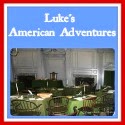
©2012- 2015 Adventures with Jude. All rights reserved. All text, photographs,
artwork, and other content may not be reproduced or transmitted in any
form without the written consent of the author.
http://adventureswithjude.com
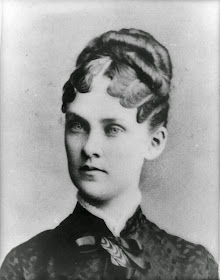

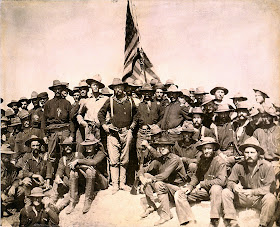
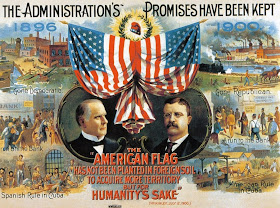

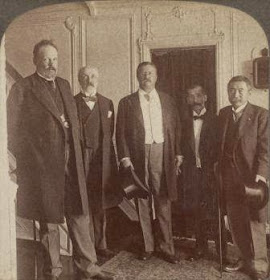
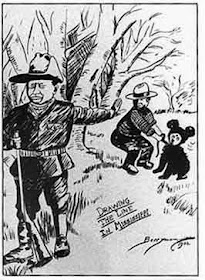
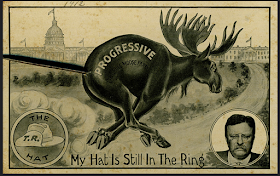



No comments:
Post a Comment